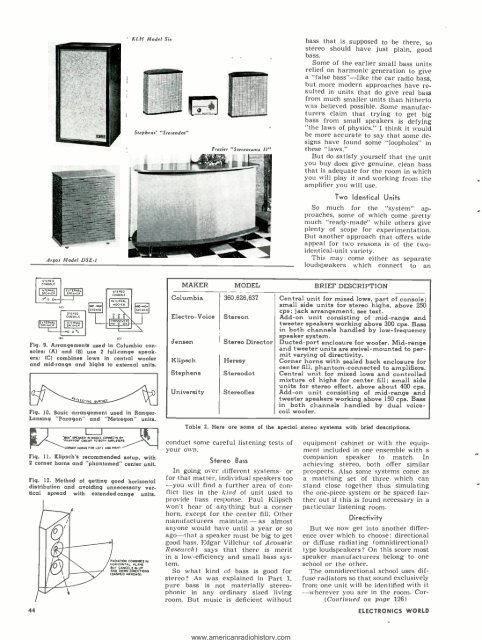Electronics-World-1959-05
Create successful ePaper yourself
Turn your PDF publications into a flip-book with our unique Google optimized e-Paper software.
www.americanradiohistory.com<br />
Argos Model DSE -1<br />
KLH Model Six<br />
Stephens' "Stereodot"<br />
Frazier " Stereorama II"<br />
bass that is supposed to be there, so<br />
stereo should have just plain, good<br />
bass.<br />
Some of the earlier small bass units<br />
relied on harmonic generation to give<br />
a "false bass" -like the car radio bass,<br />
but more modern approaches have resulted<br />
in units that do give real bass<br />
from much smaller units than hitherto<br />
was believed possible. Some manufacturers<br />
claim that trying to get big<br />
bass from small speakers is defying<br />
"the laws of physics." I think it would<br />
be more accurate to say that some designs<br />
have found some "loopholes" in<br />
these "laws."<br />
But do satisfy yourself that the unit<br />
you buy does give genuine, clean bass<br />
that is adequate for the room in which<br />
you will play it and working from the<br />
amplifier you will use.<br />
Two Identical Units<br />
So much for the "system" approaches,<br />
some of which come pretty<br />
much "ready- made" while others give<br />
plenty of scope for experimentation.<br />
But another approach that offers wide<br />
appeal for two reasons is of the two -<br />
identical -unit variety.<br />
This may come either as separate<br />
loudspeakers which connect to an<br />
I<br />
ST<br />
CO<br />
REO<br />
0"0M1<br />
Es>i?:i:l<br />
IA,<br />
CONSOLE<br />
IyREE"{nl I<br />
STEREO<br />
STEREO<br />
CONf0.1<br />
NTENNA,<br />
So<br />
TE REO<br />
m<br />
a<br />
Fig. 9. Arrangements used In Columbia consoles:<br />
(A) and (B) use 2 full -range speakers;<br />
(C) combines lows in central woofer<br />
and mid -range and highs to external units.<br />
Fig. 10. Basic arrangement used in Ranger -<br />
Lansing "Paragon and "Metregon" units.<br />
I I<br />
ANU W MIOOLE CONNECTS sT<br />
THANT0S CWC "T TO IOTw Mhe[RS<br />
CORNER HORNS FOR LEFT ND RIGHT<br />
Fig. 11. Klipsch's recommended setup, with<br />
2 corner horns and "phantomed" center unit.<br />
Fig. 12. Method of getting good horizontal<br />
distribution and avoiding unnecessary vertical<br />
spread with extended -range units.<br />
44<br />
RADIATION COMIWES IN<br />
HORIZONTAL PLANE<br />
RUT CANCELS M uR<br />
AND DOWN DIRECTIONS<br />
10A5NE0 ARROWS,<br />
MAKER<br />
Columbia<br />
Electro -Voice<br />
Jensen<br />
Klipsch<br />
Stephens<br />
University<br />
MODEL<br />
360,626,637<br />
Stereon<br />
Stereo Director<br />
Heresy<br />
Stereodot<br />
Stereoflex<br />
BRIEF DESCRIPTION<br />
Central unit for mixed lows, part of console;<br />
small side units for stereo highs, above 250<br />
cps; jack arrangement, see text.<br />
Add -on unit consisting of mid -range and<br />
tweeter speakers working above 300 cps. Bass<br />
in both channels handled by low- frequency<br />
speaker system.<br />
Ducted -port enclosure for woofer. Mid -range<br />
and tweeter units are swivel- mounted to permit<br />
varying of directivity.<br />
Corner horns with sealed back enclosure for<br />
center fill, phantom- connected to amplifiers.<br />
Central unit for mixed lows and controlled<br />
mixture of highs for center fill; small side<br />
units for stereo effect, above about 400 cps.<br />
Add -on unit consisting of mid -range and<br />
tweeter speakers working above 150 cps. Bass<br />
in both channels handled by dual voice -<br />
coil woofer.<br />
Table 2. Here are some of the special stereo systems with brief descriptions.<br />
conduct some careful listening tests of<br />
your own.<br />
Stereo Bass<br />
In going over different systems -or<br />
for that matter, individual speakers too<br />
-you will find a further area of conflict<br />
lies in the kind of unit used to<br />
provide bass response. Paul Klipsch<br />
won't hear of anything but a corner<br />
horn, except for the center fill. Other<br />
manufacturers maintain - as almost<br />
anyone would have until a year or so<br />
ago -that a speaker must be big to get<br />
good bass. Edgar Villchur (of Acoustic<br />
Research) says that there is merit<br />
in a low- efficiency and small bass system.<br />
So what kind of bass is good for<br />
stereo? As was explained in Part 1,<br />
pure bass is not materially stereophonic<br />
in any ordinary sized living<br />
room. But music is deficient without<br />
equipment cabinet or with the equipment<br />
included in one ensemble with a<br />
companion speaker to match. In<br />
achieving stereo, both offer similar<br />
prospects. Also some systems come as<br />
a matching set of three which can<br />
stand close together thus simulating<br />
the one -piece system or be spaced farther<br />
out if this is found necessary in a<br />
particular listening room.<br />
Directivity<br />
But we now get into another difference<br />
over which to choose: directional<br />
or diffuse radiating (omnidirectional)<br />
type loudspeakers? On this score most<br />
speaker manufacturers belong to one<br />
school or the other.<br />
The omnidirectional school uses diffuse<br />
radiators so that sound exclusively<br />
from one unit will be identified with it<br />
-wherever you are in the room. Cor-<br />
(Continued on page 126)<br />
ELECTRONICS WORLD



